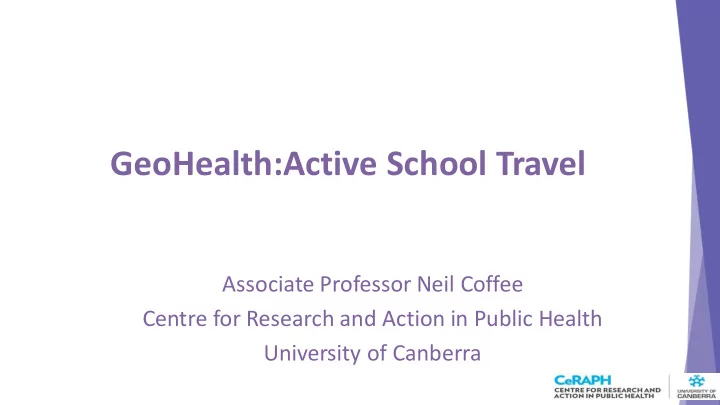

GeoHealth:Active School Travel Associate Professor Neil Coffee Centre for Research and Action in Public Health University of Canberra
Basic explanatory model for population health: Environment is fundamental Behaviour and Lifestyle Clinical Chronic Risk Disease Environment Patterns of lifestyle vary with conditions of living and the resources or supports afforded by different kinds of environments.
Tobler’s Law Tobler W., 1970, A computer movie simulating urban growth in the Detroit region, Economic Geography, 46(2): 234-240.
Place in Health Integrating spatial data into understanding OR Adding the “where” to the what!
What Natural breaks RR P 95% CI Wave 1 NWAHS, 2001, n=3585 • Factors - Log binomial generalized Central Obesity*** RLF*: 3 v 1 0.89 0.83 0.95 0.0004 • linear models 0.93 0.89 0.98 0.0033 RLF*: 2 v 1 CMR score - Poisson regression • Parameter estimates exponentiated - • Hypertriglyceridemia*** 0.79 0.70 0.90 0.0005 RLF*: 3 v 1 relative risk (RR) RLF*: 2 v 1 0.90 0.82 0.98 0.0173 Accounted for age, gender and • education (no university degree) Reduced HDL# RLF*: 3 v 1 0.79 0.67 0.92 0.0025 Statistical significance was set at • alpha = 0.05 RLF*: 2 v 1 0.87 0.78 0.97 0.0159 Statistically significant relationship • Hypertension*** RLF*: 3 v 1 0.94 0.88 1.01 0.0824 between RLF & CMR score all but one of the risk factors. 0.90 0.85 0.95 <.0001 RLF*: 2 v 1 Participants in the advantaged and • Diabetic\diabetes Risk*** 0.52 0.43 0.64 <.0001 RLF*: 3 v 1 intermediate group had a lower risk for CMD. RLF*: 2 v 1 0.79 0.70 0.89 <.0001 CMR score RR for the most • High LDL^ RLF*: 3 v 1 0.95 0.77 1.17 0.6277 advantaged was 19% lower (RR = 0.81; CI 0.76-0.86; p <0.0001) and the 1.05 0.90 1.23 0.5399 RLF*: 2 v 1 middle group was 9% lower (RR = CMR Score*** 0.81 0.76 0.86 <.0001 RLF*: 3 v 1 0.91; CI 0.86-0.95; p <0.0001) than the least advantaged group. RLF*: 2 v 1 0.91 0.86 0.95 <.0001 Gender, Age and Bachelor Education were included in all models. *** Gender, Age and Bachelor Education Significant # Gender Significant ^ Age Significant Coffee et al. International Journal of Health Geographics 2013, http://www.ij-healthgeographics.com/content/12/1/22 * RLF – a property based socioeconomic status measure
Where ! Education is a measure used to express socioeconomic status If we look at how education is spatially distributed and Diabetes risk! This provides the Where
In this case: What What is the significant reductions in child physical activity
• What : Children are not active enough • Solution : more activity • Active travel to school is key focus
Ride or Walk to School Initiative Walking Routes to Schools Objectives for CERAPH: -Identify the optimal walking and/or cycling routes for each pilot school, based on distance, safety and amenity -Create walking/cycling maps to enable active transport to school Initial Scope: 20 Schools in Canberra Based on 1km straight line buffer identify specific facilities: · Pedestrian crossings · Traffic light crossings · Bus stops · Underpasses/overpasses · Shared use paths · Playgrounds · Skateboard parks · Public toilets · Recommended walking routes · Drop off points identified · Routes or circumferences of 1km from school and estimated time · Map which shows a close-up of the school entry points and pedestrian crossings · Map which shows a circumference of 5km radius from the school and showing the main trunk paths Process: Provide draft maps to ACT Health which are then provided to schools to provide feedback on drop off points and routes. Integrate this feedback into final poster style maps. Acknowledgements: Vincent Learnihan and Rachel Davey @ CeRAPH
Ride or Walk to School Initiative Walking Routes to Schools In addition to creating cycling/walking maps to enable safe active travel to school, CeRAPH can build on its foundation of population health research expertise to better understand how health outcomes in the community can be improved. Opportunities include; 1. Evidence based research into the factors that promote active travel to school. 2. Collaborating with key partners across the ACT, Nationally and Internationally to identify cutting edge approaches to increasing physical activity in our communities. 3. Continue to build a data repository for the exploration and creation of local level indicators that may influence population health outcomes in the ACT. CeRAPH’s GeoHealth Hub provides national data to provide context for research
Ride or Walk to School Initiative Walking Routes to Schools: Research Translation Increasing physical activity participation in youth through reducing • barriers (both physical and perception of) to walking and cycling to school for children in the ACT. The development of an evidence based tool which identifies and • prioritises active transportation improvements in school areas based on a range of outcomes including: - Health (Physical Activity, Traffic Safety) - Transportation (Accessibility) - Social Equity - Environmental targets Identify infrastructure improvements to make safe routes to school • Input into future school siting •
Safe routes to School: Role of GIS • Propose to use GIS in schools to collect data from the “bottom-up” • Students will feed data on routes travelled • Danger spots • Safe spots etc • UC will apply built environment data from the GeoHealth Hub to place these data in context
Outcome • Work with schools to synthesize data to identify infrastructure needs to make riding and walking to school safer • Prioritise items • Submission to local and state governments
Thank You
Recommend
More recommend